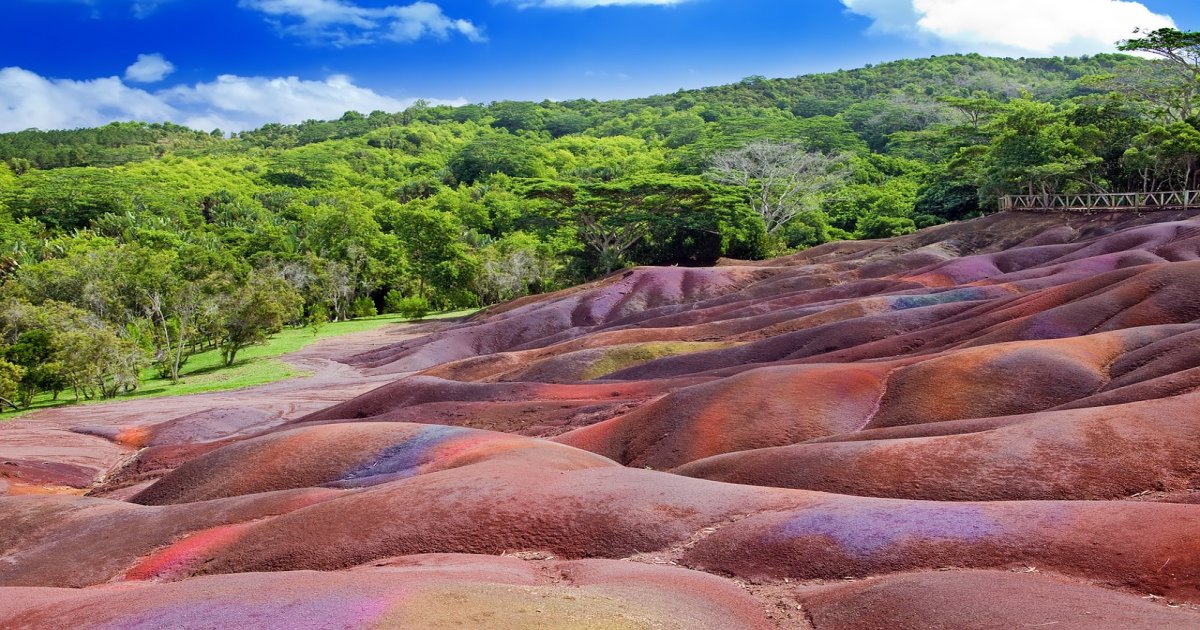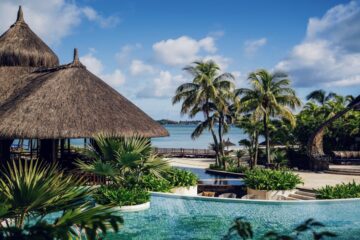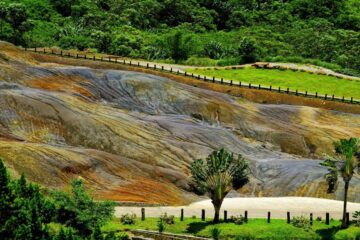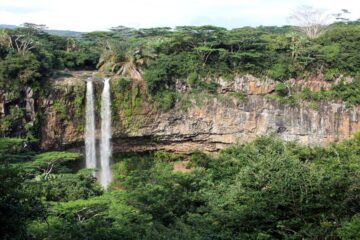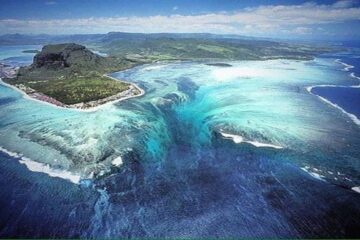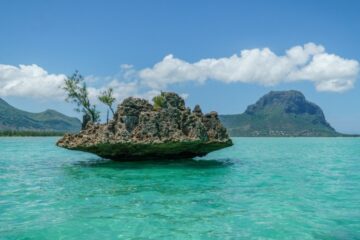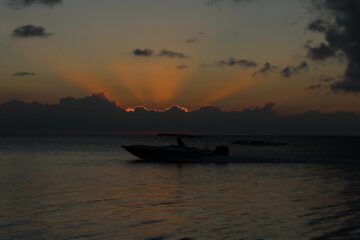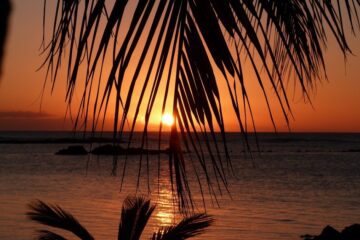Chamarel Colored Earths, also called the Seven Colored Earths, is a natural feature in the Chamarel area in the southwestern part of the island of Mauritius. It is a famous tourist attraction due to its unique natural features.
The Chamarel Colored Earths are a group of sand dunes that are made up of different shades of red, brown, violet, blue, and green sand. The weathering of volcanic rocks over time has led to the formation of different minerals with different colors, which give these rocks their bright colors.
People think that the different colors of the sand dunes are caused by layers of different minerals that were made when volcanic ash cooled at different rates. The red, brown, and purple colors come from iron oxides and aluminum oxides, while the blue and green colors come from mineral-rich volcanic ash.
One interesting thing about the Chamarel Colored Earths is that if you mix the sands together, they will naturally split and settle into different color layers due to their different densities. This natural phenomenon makes the place even more interesting and special.
The Chamarel area is a popular place for tourists to visit in Mauritius because it has colorful sands, a nearby waterfall, lush greenery, and great views.
Why is the earth at Chamarel multi Coloured?
In Chamarel, Mauritius, the multicolored earth is the result of a variety of minerals and geological processes. Chamarel is known for its “Seven Colored Earths,” which are sand hills with different colors like red, brown, violet, blue, green, and yellow.
The unique colors come from weathering and volcanic action that happened millions of years ago. The different colors come from the different minerals that exist in the soil, which is a natural reason. Most of the colors come from iron oxides and aluminum oxides, as well as elements like copper and calcium.
Over time, these rocks changed colors as a result of oxidation, leaching, and other chemical processes. The red and brown colors come from iron oxides, while the blue and green colors come from copper elements. The different colors come from the way rocks are mixed and how much of them are in each place.
Also, these bright colors change and stay bright because they are exposed to sunshine, humidity, and the damage caused by wind and rain. It’s important to remember that the colors may look brighter after it rains because the moisture makes them easier to see.
What are the different colors in Chamarel Seven Colored Earths?
Most of the different colors of the Chamarel Colored Earths come from the different minerals in the sand. The various shades of the scenery are caused by the rocks that are found in each layer. Here’s a list of the colors and the minerals that make up each one:
1. Red:
Iron oxide minerals, such as hematite, make up most of the red layers. Hematite is a mineral that is high in iron and gives the sand its red color. The strong red color comes from the high amount of iron in these layers.
2. Brown:
The brown layers also have iron oxide minerals, but their makeup is a little different than that of the red layers. The dark color comes from the different amounts of iron and the presence of other minerals.
3. Purple:
Iron and aluminum particles come together to make the purple layers. When aluminum minerals and iron are present, they mix to make purple colors. The purple color may come from a different mix of minerals in each of these layers.
4. Violet:
The minerals in the violet layers are the same as the minerals in the purple layers. The violet color comes from the way the rocks are arranged and how many of them there are. This gives the environment another unique shade.
5. Blue:
The blue layers have minerals like magnesium and calcium, which can combine to make compounds like chlorite or pyroxene. The blue color comes from these mineral combinations. Some places have blue colors because of these minerals and other things, like the way light is scattered and absorbed.
6. Green:
Just like the blue layers, the green layers also have minerals like magnesium and calcium. Green shades are caused by a certain mix of minerals and natural factors. Minerals like olivine, which can be found in the rock, can also make it green.
It’s important to remember that the exact types and amounts of minerals in Chamarel Colored Earths can be different in different areas and places. Geological history and processes, like volcanic activity, weathering, and erosion, have played a big role in making this interesting natural phenomenon with its many different colors.
How to reach Chamarel’s seven colored Earths?
Follow these steps to get to the Seven Colored Earths at Chamarel in Mauritius:
1. Flying to Mauritius:
Check for flights to Mauritius’s largest international airport, Sir Seewoosagur Ramgoolam International Airport (MRU).
2. Traveling to Chamarel:
Chamarel is on Mauritius’s southwestern side. You can get to Chamarel from the airport or other places on the Island in a number of ways:
- Taxi: You can get a taxi at the airport and have it take you straight to Chamarel. It’s best to talk about the price ahead of time or make sure the cab uses a meter.
- Car Rental: If you rent a car, you have more freedom to get around the island. Mauritius has many places where you can rent a car, and you can do it at the airport or ahead of time.
- Guided Tours: Another easy choice is to join a guided tour. Several tour companies offer full-day or half-day tours that go to Chamarel and other places of interest in the area.
Read more here; How many days do you need to visit Mauritius?
3. Find your way in Chamarel:
Once you get to Chamarel, it’s easy to get to the Seven Colored Earths. Here’s what you should do:
- Follow the signs to Chamarel Village if you are driving. The Seven Colored Earths are near the town and are easy to find. There is a place to park your car.
- If you want to explore Chamarel on foot, you can walk from the town to the Seven Colored Earths. It’s a short journey, and you can enjoy the beautiful scenery as you go.
4. Navigate to the Seven Colored Earths:
When you get to the spot, you’ll find viewing platforms and paths that let you see and enjoy the dunes’ unique colors. Take your time to look around and enjoy the beauty of the place.
Note: Make sure to follow any rules or guidelines that the officials give you to protect the spot and keep everyone safe. Before you go to Chamarel, you should always check the latest journey information, road conditions, and entry requirements.
5. Most booked tours in Chamarel:
Read also; Chamarel Waterfall, the hidden gem of Mauritius.
How did the seven Coloured Earths form?
The Seven Colored Earths at Chamarel in Mauritius are thought to have been made over millions of years by volcanic activity, weathering, and other natural processes. Here’s a breakdown of how it might have come to be:
1. The activity of Volcanoes:
Chamarel is in a place that used to be a volcano. Volcanoes are thought to have erupted in the area, sending liquid lava and volcanic ash into the air.
2. Cooling down and getting solid:
Lava and ash, which were made by volcanoes, cooled and hardened over time. This mineral that has hardened is called basalt.
3. The effects of time and water:
As time went on, things like wind, rain, and changes in temperature started to break up the basalt into smaller pieces.
4. Minerals Made Up Of:
The chemicals in the basaltic rocks were varied. They included iron, aluminum, copper, calcium, and other minor elements.
5. Leaching and oxidation:
Some of the chemical processes that happened to the minerals in the basalt were weathering and leaching. Minerals made of iron and aluminum combined with air and water to make iron oxides and aluminum oxides.
6. How Colors Form:
Due to the different minerals and other minor elements, the soil has a wide range of colors. Iron oxides make the colors red and brown, copper minerals make the colors blue and green, and other minerals may make the colors yellow and pink.
7. Preservation:
The colors were kept and made brighter by the sun, the humidity, and the ongoing fading and erosion processes.
Today, the Seven Colored Earths have a unique and fascinating show of these different colored rocks. People come from all over the world to see this natural wonder. People work to protect and keep this frail rock structure around so that future generations can enjoy its beauty.
Where to stay in Seven Colored Earths?
In the southwest of Mauritius, the Chamarel Colored Earths is a famous place for tourists to visit. Even though there are no places to stay at the spot itself, there are a number of places to stay in the area. Here are some places to stay close to the Seven Colored Earths:
1. Lakaz Chamarel Exclusive Lodge:
This lodge is close to Chamarel and offers high-end rooms in a quiet and private setting. It’s a one-of-a-kind lodge with beautiful views of the mountains and woods nearby.
2. Le Morne:
A nearby region called Le Morne is known for its beautiful beaches and high-end resorts. If you stayed at one of the villas in this area, you could visit Chamarel’s sights during the day and unwind on the beach at night.
Booking.com3. Black River:
The town of Black River is close to the town of Chamarel. It has a variety of places to stay, such as restaurants and guesthouses. It’s a good place to stay if you want to visit both the Chamarel Colored Earths and nearby places like Black River Gorges National Park or Tamarin Bay.
4. Flic-en-Flac:
Flic-en-Flac is another beach town with a wide range of places to stay, from cheap hotels to high-end resorts. It’s a popular place for tourists to visit because it has beautiful beaches and a lively vibe.
Note: when picking a place to stay, think about your income, the amount of comfort you want, how close it is to other sites, and how you will get there. It’s best to book your stay ahead of time, especially during busy travel times, to make sure there are rooms available.
FAQ
The Seven Colored Earths is a natural geological phenomenon found in Chamarel, a village in southwest Mauritius. It means a unique scenery made up of sand dunes that come in a wide range of bright colors. These sand dunes at Chamarel have colors like red, brown, pink, blue, green, and yellow.
The Chamarel Seven Colored Earths in Mauritius are made of old volcanic ash and basaltic rock. So, the underlying rock formation in the area is basalt, a typical kind of volcanic rock, and the colorful sands were formed over time as a result of weathering and erosion processes.
Chamarel’s earth is different colors because of natural processes and the different minerals in the soil.

